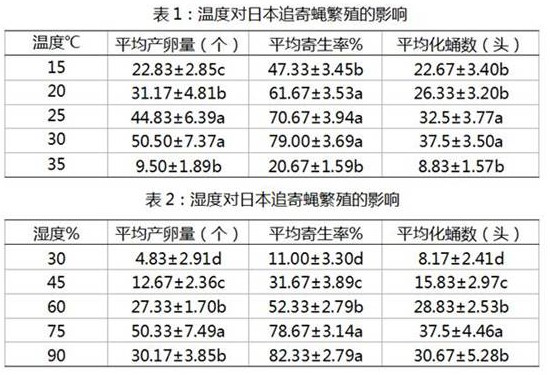A kind of method that utilizes greater wax moth to breed Japanese parasite fly
A technology of wax moth and parasitic fly chasing, applied in animal husbandry, etc., can solve the problem of low host parasitism rate, achieve high reproductive efficiency, strong ability to rely on hunger, and low feeding cost
- Summary
- Abstract
- Description
- Claims
- Application Information
AI Technical Summary
Problems solved by technology
Method used
Image
Examples
Embodiment 1
[0020] (1) Collection of Provenance
[0021] Collect the mature larvae of the large bag moth, put them into the fly collection cage, collect the Japanese chasing fly adults and move them into the new fly collection cage as a provenance, and remove the weak and deformed parasite flies. 50 Japanese chasing flies were moved into each cage, and the ratio of male to female was 2-3:2. Put into 20% honey water in the cage, supplement nutrition for the adult.
[0022] (2) Inoculation
[0023] After the parasites were moved into the breeding cage for 3 days, 50 mature larvae of the wax moth which were treated with 75% alcohol + 60°C hot water were placed in a petri dish, put into the breeding cage, and parasite eggs were collected every 2 hours.
[0024] (3) Collection of parasite eggs
[0025] Take out the petri dish, observe it under a dissecting microscope, move the larvae of the parasitic fly, Melonella mellonella, which have laid eggs, into a disposable transparent plastic cup,...
PUM
 Login to View More
Login to View More Abstract
Description
Claims
Application Information
 Login to View More
Login to View More - R&D
- Intellectual Property
- Life Sciences
- Materials
- Tech Scout
- Unparalleled Data Quality
- Higher Quality Content
- 60% Fewer Hallucinations
Browse by: Latest US Patents, China's latest patents, Technical Efficacy Thesaurus, Application Domain, Technology Topic, Popular Technical Reports.
© 2025 PatSnap. All rights reserved.Legal|Privacy policy|Modern Slavery Act Transparency Statement|Sitemap|About US| Contact US: help@patsnap.com

